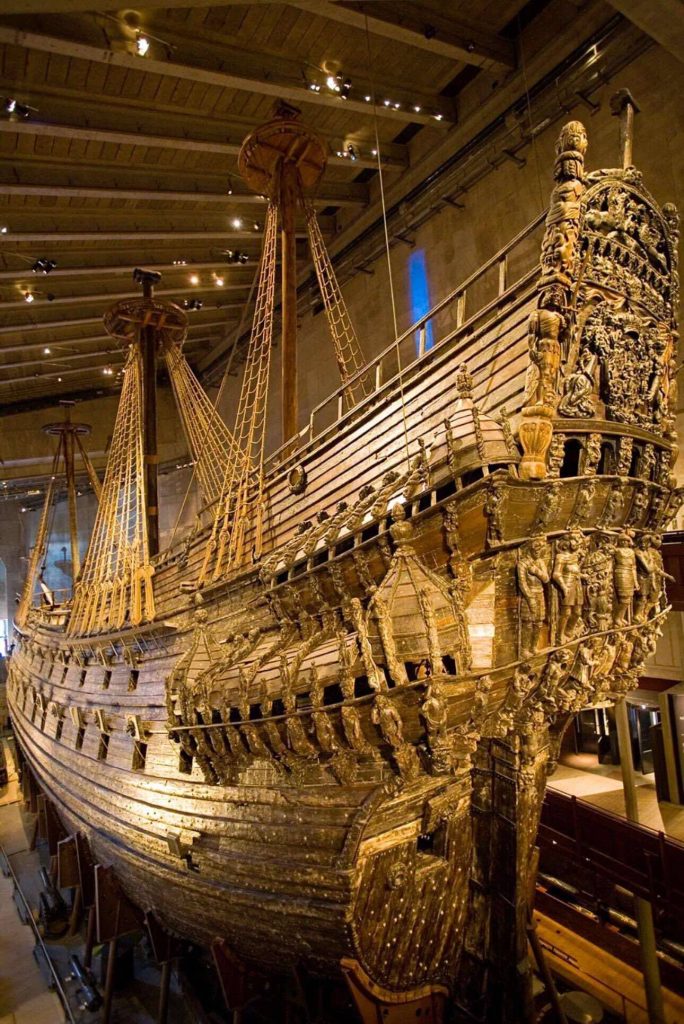The Vasa, a Swedish warship constructed between 1626 and 1628, holds one of the most peculiar and tragic places in maritime history. Intended as a powerful symbol of Sweden’s naval supremacy, it was among the most ambitious and elaborately designed warships of its time. However, despite its grandeur, the Vasa met an unfortunate fate, sinking a mere twenty minutes into its maiden voyage on August 10, 1628. The ship had only sailed about 1,300 meters (1,400 yards) from shore before it was swallowed by the sea.

“The warship survived the first blast of wind it encountered on its maiden voyage in Stockholm Harbor,” writes Lucas Laursen for Archaeology. “But the second gust did it in. The sinking of Vasa took place nowhere near an enemy. In fact, it sank in full view of a horrified public, assembled to see off their navy’s—and Europe’s—most ambitious warship to date.”
The Vasa’s downfall was the result of significant engineering miscalculations. This naval catastrophe, a devastating blow to Sweden’s maritime reputation, has ironically turned into a priceless archaeological treasure.
A Monument to Swedish Ambition
Built at the Stockholm navy yard under the orders of King Gustav II Adolf, the Vasa was a massive and beautifully decorated vessel, designed to project the strength and dominance of the Swedish empire. The ship’s wooden carvings were intricate works of art, each telling stories of Swedish royalty, particularly celebrating the power and legacy of the king himself.
Standing tall with towering masts and ornate sculptures, the Vasa was a sight to behold. A 1:10 scale model displayed at the Vasa Museum in Stockholm showcases how the ship once looked, with its sculptures painted in vibrant colors believed to match the original hues on the day of its launch.
Despite being one of the most heavily armed warships of its era, the Vasa suffered from a critical design flaw. The ship’s structure was dangerously unstable, with excessive weight concentrated in the upper levels of the hull. This imbalance made it prone to tipping over, a flaw that became painfully evident on its maiden voyage.
A Doomed Journey
As the Vasa set sail, its lower gun ports were open, having just fired a ceremonial salute. When a sudden gust of wind hit, the ship tilted, allowing water to rush into the gun ports. The warship, unable to recover from the imbalance, quickly succumbed to the sea, taking many crew members down with it.
The disaster was an immense humiliation for Sweden, particularly for King Gustav II Adolf, who had personally overseen the ship’s construction. However, the ship’s fate was sealed long before it even left the dock. Tests conducted prior to the launch had already indicated severe stability issues, yet political pressure and the urgency of war led to the decision to proceed with its departure.
A Preservation Miracle
Though it was a failure as a warship, the Vasa has provided modern archaeologists with an extraordinary window into 17th-century naval warfare, shipbuilding techniques, and daily life. The cold, oxygen-poor waters of the Baltic Sea preserved the wreck remarkably well, protecting it from the usual wood-consuming bacteria and shipworms that typically destroy wooden vessels. By the time Sweden raised the wreck in 1961, approximately 95 percent of the original wood remained intact.
The ship’s recovery was a monumental achievement in marine archaeology. Thousands of artifacts, along with the remains of at least 15 crew members, were discovered inside and around the hull. These findings included clothing, weapons, cannons, tools, coins, cutlery, food, beverages, and even six of the ten original sails.
Raising the Vasa
The process of salvaging the Vasa was as ambitious as the ship’s original construction. Engineers devised an intricate plan involving steel cables and floating pontoons to carefully lift the wreck from the seabed. Detailed sketches illustrate how the ship was gradually moved from the wreck site before finally being hoisted to the surface in 1961.
When the Vasa finally emerged from its watery grave, it was an astonishing sight. Despite having spent over three centuries underwater, much of the ship’s structure was still intact, offering an unprecedented glimpse into early 17th-century maritime craftsmanship.
A Window into the Past
Today, the Vasa stands proudly in the Vasa Museum in Stockholm, where it continues to captivate millions of visitors. Scholars have used the ship and its artifacts to gain deeper insights into the technology and craftsmanship of the time. The ship’s gun deck, its beautifully carved stern, and various components of its upper deck provide invaluable knowledge about naval engineering and life aboard a 17th-century warship.
Even the ship’s smaller details—such as knightheads (posts used to fasten ropes) and decorative carvings—offer insights into the artistic traditions and functional aspects of naval construction in the Swedish empire. Some of these carvings, once vividly detailed, have been eroded by the currents of Stockholms ström, yet they remain a testament to the intricate artistry of the period.
A Legacy That Lives On
The Vasa’s legacy extends far beyond Sweden. The ship has inspired replicas, including sightseeing vessels designed to resemble the historic warship, such as the one on Lake Ashi in Japan. The story of the Vasa continues to fascinate historians, archaeologists, and maritime enthusiasts worldwide.
While the ship’s sinking was a catastrophe in its time, it has since become one of the most well-preserved and significant archaeological discoveries in maritime history. The Vasa is more than just a ship—it is a time capsule, offering a vivid, tangible connection to Sweden’s naval past.
For visitors standing before the towering structure of the Vasa in the museum, it is hard not to marvel at its sheer scale and intricate craftsmanship. This once-doomed warship now serves as a powerful reminder of human ambition, engineering miscalculations, and the enduring ability of history to teach us lessons about the past.





